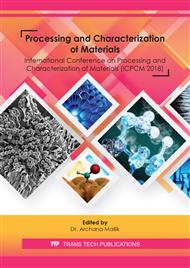[1]
B. S. Brown, Radiation effects in Superconducting Fusion magnet materials, J. Nucl. Mat. 97(1981) 1-14.
Google Scholar
[2]
S. Beura, D. N. Thatoi, A. P. Chakraverty, U. K. Mohanty, Impact of the ambiance on GFRP composites and role of some inherent factors: A review report, J. Reinf. Plast Compos. 37 (2018) 533-547.
DOI: 10.1177/0731684418754359
Google Scholar
[3]
J. L. Scott, F. W. Jr. Clinard, F. W. Wiffen, Special purpose materials for fusion application, J. Nucl. Mat. 133-134 (1985) 156-163.
DOI: 10.1016/0022-3115(85)90126-6
Google Scholar
[4]
Y. Zhai, P. Titus, C. Kessel, L. El-Guebaly, Conceptual magnet design study for fusion nuclear science facility, Fusion Eng. Des. 135 (2018) 324-336.
DOI: 10.1016/j.fusengdes.2017.06.028
Google Scholar
[5]
J. Megusar, Low temperature fast-neutron and gamma-irradiation of glass fibre-epoxy composite: Part 2: Structure and ChemistrY, J. Nucl. Mat. 230 (1996) 233-241.
DOI: 10.1016/0022-3115(96)80019-5
Google Scholar
[6]
Z. Wu, J. W. Li, C. J. Huang, R. J. Huang, L. F. Li, Effect of gamma irradiation on the mechanical behavior, thermal properties and structure of epoxy/glass-fiber composite, J. Nucl. Mat. 441 (2013) 67-72.
DOI: 10.1016/j.jnucmat.2013.05.041
Google Scholar
[7]
H. Kaouacha, F. Hosnib, M. Daoudia, A. Bardaouia, K. Farahbc, H. Hamzaouid, R. Chtourou, Effects of gamma irradiation on photoluminescence and activation energy of epoxy resin, Superlattices Microstruct. 55 (2013) 191-197.
DOI: 10.1016/j.spmi.2012.10.015
Google Scholar
[8]
J. M. Pintado, J. Miguel, Effects of - radiation on Mechanical behaviour Carbon/Epoxy Composite Materials, Cryogenics. 38 (1998) 85-89.
DOI: 10.1016/s0011-2275(97)00115-x
Google Scholar
[9]
L. Xing, L. Liu, Y. Huang, D. Jiang, B. Jiang, J. He, Enhanced interfacial properties of domestic aramid fiber-12 via high energy gamma ray irradiation, Composites Part B. 69 (2015) 50-57.
DOI: 10.1016/j.compositesb.2014.09.027
Google Scholar
[10]
S. Tiwari, J. Bijwe, S. Panier, Gamma radiation treatment of carbon fabric to improve the fiber–matrix adhesion and tribo-performance of composites, Wear. 271 (2011) 2184-2192.
DOI: 10.1016/j.wear.2010.11.032
Google Scholar
[11]
S. Egusa, T. Seguchi, Polymer composites as magnet materials: Irradiation effects and degradation mechanism of mechanical properties, J. Nucl. Mat. 179-181 (1991) 1111-1119.
DOI: 10.1016/0022-3115(91)90286-g
Google Scholar
[12]
A. P. Chakraverty, U. K. Mohanty, S. C. Mishra, A. Satapathy, Sea Water Ageing of GFRP Composites and the Dissolved salts, IOP Conf. Series: Mat. Sc. & Engg. 75 (2015) 012029.
DOI: 10.1088/1757-899x/75/1/012029
Google Scholar
[13]
A. P. Chakraverty, U. K. Mohanty, B. B. Biswal, Thermal shock behavior of hydrothermally conditioned e-glass fi ber/epoxy composites, Emer. Mat. Res. 1 (2012) 263-270.
DOI: 10.1680/emr.12.00009
Google Scholar
[14]
A. Broido, A simple, sensitive Graphical Method of Treating Thermogravimetric Analysis Data, J. Polym. Sci. Part-2. 7 (1969) 1761-1773.
DOI: 10.1002/pol.1969.160071012
Google Scholar
[15]
E. N. Hoffman, T. E. Skidmore, Radiation effects on epoxy/carbon-fiber composite, J. Nucl. Mat. 392 (2009) 371-378.
DOI: 10.1016/j.jnucmat.2009.03.027
Google Scholar
[16]
Y. Gao, S. Jiang, D. Yang, S. He, J. Xiao, Z. Li, A study on radiation effect of < 200 keV protons on M40J/epoxy composites, Nuclear Instruments and Methods in Physics Research Section B. 229 (2005) 261-268.
DOI: 10.1016/j.nimb.2004.11.030
Google Scholar
[17]
H. Harayma, M. Al-Sheikhly, J. Silverman, Oligomer formation in the radiation induced polymerization of styrene, Radiat. Phys. Chem. 68 (2003) 1023-1029.
DOI: 10.1016/j.radphyschem.2003.06.001
Google Scholar
[18]
N. Longiéras, M. Sebban, P. Palmas, A. Rivaton, J. L. Gardette, Degradation of epoxy resins under high energy electron beam irradiation: Radio-oxidation, Polym. Degrad. Stab. 92 (2007) 2190-2197.
DOI: 10.1016/j.polymdegradstab.2007.01.035
Google Scholar


